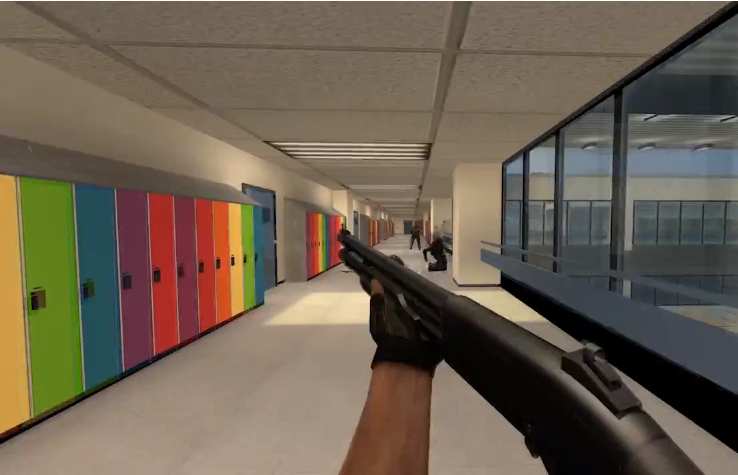Online re-creation of local secondary school in first-person shooter video game stirs questions of where virtual violence meets reality
By Sharon Miki, Editor in Chief
Imagine walking through the familiar hallways of your old high school. You see the dusty classrooms where you sweated through exams in, the worn lockers that once contained your personal treasures, and the shiny trophies you fought hard for on the field. Sufficiently filled with yearbook-esque nostalgia? Now imagine re-visiting those same hallways, but this time armed with guns and ammo amidst a hail of gunfire.
Are you excited, or horrified? This is the situation faced by former Port Moody Secondary School (PMSS) students in the wake of recent controversy over the release of a detailed virtual re-creation of their school—as a map for the first-person shooter game.
The source of the controversy is a preview of a virtual map of PMSS made for the tactical game Counter-Strike: Source. Counter-Strike, which has gone through a number of iterations over the past decade, is a team-based social game where players take the role of either terrorists or anti-terrorists with the mission of eliminating each other. One of the features of Counter-Strike is that game developers (and fans with developer skills) are able to create their own virtual environments in which the game can be played, called “maps”—which is exactly what the PMSS Counter-Strike creators did.
A preview of the map released last week on YouTube shows a detailed rendering of the local school, panning from the building’s stony exterior architecture to its trademark rainbow lockers inside. The preview shows astonishing detail and effort, even going so far as to show a banner proudly bearing the school’s name.
“Thousands of hours were spent in development to create an accurate, to-scale, digital replication of the school,” explained one former-PMSS student who worked on the creation of the game in a statement.
The map is indeed incredibly lifelike and accurate. This true-to-life quality, however, takes a turn that is unsettling for some when it begins to integrate the Counter-Strike aspects of shooting and bloodshed, as representations of players move around the school shooting each other down. In the wake of a growing number of fatal school shootings in recent years, the setting of the map has caused an uproar of reactions. Is depicting shooting sprees in real school environments a legitimate artistic expression in an era of life-like gaming, or is it a sensationalist exhibition of dangerous violent tendencies?
Among former PMSS students, for whom the map is a blast from the real-life past, reactions to the game map are mixed.
“In the light of recent gun violence, there is something really scary about someone turning a school (whether it be my school, or any school, really) shooting into a game,” said PMSS graduate Alex Mierke-Zatwarnicki, who noted that her initial reaction to the video was of “shock and disgust.”
On the contrary, another PMSS alumnus, Haider Navani, viewed the game as an innocent creative endeavour. “I saw [the map as] a popular game that many Port Moody Secondary students played, offered in an environment they were familiar with.”
Indeed, it seems that the familiarity of the location is one of the major causes of both appeal and repulsion to the game—and part of its genesis. In their statement, the developers stressed the specifics of PMSS as a major purpose for the map’s creation. “[The map’s] architecture and design is rather ideal for the game’s tactics. Furthermore, this is a location we are quite familiar with already. Additionally, supporters and fellow alumni are also likely familiar with this location, which makes it an ideal common ground for this game and its intended audience.”
In interviews, supporters of the map stressed the value to gamers of having intimate knowledge on an environment—not for violent purposes, but for enhanced gameplay. Joel McCarthy, a 2008 graduate of PMSS, echoed Navani’s admiration of the game as a creative and technical pursuit, and for the value of its location for improving gameplay: “I saw the novelty of playing a video game in a location that I knew well and thought [the map] had an interesting concept. I find when I play first-person shooter games, the hard-core players know the maps so intimately that it’s hard for me to compete and I’m sometimes turned off of playing because of that.”
Others, like 22-year-old Joel MacKenzie, disagree with the necessity of setting the map at a school as a way of evoking the familiar for gamers. “[In their statement, the developers] argued that they wanted a map of a familiar setting; it goes without saying that there are countless other familiar, less controversial places they could have chosen.” MacKenzie, once an avid first-person gamer himself, went on to argue that the location of the map pushes the game into a new and disturbing arena. “[T]his map puts violence in a children’s setting, where strikingly similar violence has taken place in the past. It’s unnecessary. It seems purposefully offensive, in a way that’s so obvious it hardly needs to be mentioned.”
Whether or not they believe that setting the map at a school is ingenious or in poor taste, a larger question for many is if first-person shooter games, like Counter-Strike, have a negative impact on gamers—and if further connecting this violence to real life is dangerous. Does virtual impact reality?
“I do feel there is a connection between violent video games and real-life violence,” said MacKenzie. “Modern first-person shooters are incredibly realistic, and pair heightened, personal emotions with violence. This doesn’t mean that these games create killers, but they do encourage more aggression in general. At the same time, I feel that it would be naive to eliminate violent video games completely: people are intrinsically interested in violence, as reflected in the continuous pattern of violence from ancient stories until now.”
Mierke-Zatwarnicki, now a political science student at the University of British Columbia, stated slightly different concerns: “One of the main issues for me was less that it would cause an individual to become violent, but more that if there already is someone at Port Moody who is considering taking a violent stand, this type of simulation could serve as a practicing ground for them and amplify the sheer amount of risk they might pose. I know it is all hypothetical, but the potential is there.”
Still, the map’s creators stressed their belief in the separation between violent games and real-life violence: “We… think that players of this map and games like this will be sufficiently mature to realize that the degrees of freedom allotted to you in the virtual realm do not extend to your rights in reality.”
Regardless of the developers’ intentions, the Port Moody Secondary School Counter-Strike map preview has undeniably caused an uproar in the Tri-Cities community, as well as on both social media and on major news outlets. With the abundance of attention, largely negative, towards the project, one can’t help but wonder whether the developers’ attitudes towards their work have changed. According to their statement, they stand by their work.
“[T]here is no malicious intent behind this production to any actual school property, nor any actual persons associated with the school. We also believe that we are not violating any laws. We have confirmation from local law enforcement that we have done nothing illegal.”
Whether or not the Port Moody Secondary School Counter-Strike map is ever released to use, the aftermath of this preview shows that gaming is not always play for everyone.



